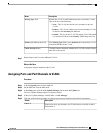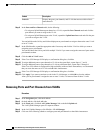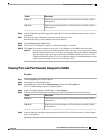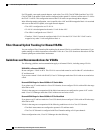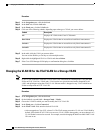
1
Renders all VSANs with an ID in the range from 3840 to 4079 non-operational.
2
Raises a fault against the non-operational VSANs.
3
Transfers all non-operational VSANs to the default VSAN.
4
Transfers all vHBAs associated with the non-operational VSANs to the default VSAN.
If you disable Fibre Channel trunking and delete any existing SAN port channels, Cisco UCS Manager returns
all VSANs in the range from 3840 to 4078 to an operational state and restores any associated vHBAs back
to those VSANs.
Range Restrictions for Named VSAN IDs in FC Switch Mode
If you plan to use FC switch mode in a Cisco UCS domain, do not configure VSANs in the range from 3040
to 4078.
When a fabric interconnectoperating in FC switch mode is connected toMDS as the upstream switch, VSANs
configured in Cisco UCS Manager in the range from 3040 to 4078 and assigned as port VSANs cannot be
created in MDS. This configuration results in a possible port VSAN mismatch.
Guidelines for FCoE VLAN IDs
FCoE VLANs in the SAN cloud and VLANs in the LAN cloud must have different IDs. Using the same
ID for an FCoE VLAN in a VSAN and a VLAN results in a critical fault and traffic disruption for all
vNICs and uplink ports using that FCoE VLAN. Ethernet traffic is dropped on any VLAN which has an
ID that overlaps with an FCoE VLAN ID.
Note
VLAN 4048 is user-configurable. However, Cisco UCS Manager uses VLAN 4048 for the following default
values. If you want to assign 4048 to a VLAN, you must reconfigure these values:
The default FCoE VLAN varies according to the type of VSAN and whether Cisco UCS is a fresh installation
or an upgrade, as follows:
• After an upgrade to Cisco UCS, release 2.0: The FCoE storage port native VLAN uses VLAN 4048 by
default. If the default FCoE VSAN was set to use VLAN 1 before the upgrade, you must change it to a
VLAN ID that is not used or reserved. For example, consider changing the default to 4049 if that VLAN
ID is not in use.
• After a fresh install of Cisco UCS, release 2.0: The FCoE VLAN for the default VSAN uses VLAN
4048 by default. The FCoE storage port native VLAN uses VLAN 4049.
Creating a Named VSAN
FCoE VLANs in the SAN cloud and VLANs in the LAN cloud must have different IDs. Using the same
ID for an FCoE VLAN in a VSAN and a VLAN results in a critical fault and traffic disruption for all
vNICs and uplink ports using that FCoE VLAN. Ethernet traffic is dropped on any VLAN which has an
ID that overlaps with an FCoE VLAN ID.
Note
Cisco UCS Manager GUI Configuration Guide, Release 2.0
OL-25712-04 335
Creating a Named VSAN



